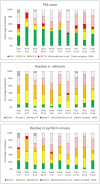Characterization of dysphagia and laryngeal findings in COVID-19 patients treated in the ICU-An observational clinical study
- PMID: 34086717
- PMCID: PMC8177545
- DOI: 10.1371/journal.pone.0252347
Characterization of dysphagia and laryngeal findings in COVID-19 patients treated in the ICU-An observational clinical study
Abstract
Background: Dysphagia appears to be common in patients with severe COVID-19. Information about the characteristics of dysphagia and laryngeal findings in COVID-19 patients treated in the intensive care unit (ICU) is still limited.
Objectives: The aim of this study was to evaluate oropharyngeal swallowing function and laryngeal appearance and function in patients with severe COVID-19.
Method: A series of 25 ICU patients with COVID-19 and signs of dysphagia were examined with fiberendoscopic evaluation of swallowing (FEES) during the latter stage of ICU care or after discharge from the ICU. Swallowing function and laryngeal findings were assessed with standard rating scales from video recordings.
Results: Pooling of secretions was found in 92% of patients. Eleven patients (44%) showed signs of silent aspiration to the trachea on at least one occasion. All patients showed residue after swallowing to some degree both in the vallecula and hypopharynx. Seventy-six percent of patients had impaired vocal cord movement. Erythema of the vocal folds was found in 60% of patients and edema in the arytenoid region in 60%.
Conclusion: Impairment of oropharyngeal swallowing function and abnormal laryngeal findings were common in this series of patients with severe COVID-19 treated in the ICU. To avoid complications related to dysphagia in this patient group, it seems to be of great importance to evaluate the swallowing function as a standard procedure, preferably at an early stage, before initiation of oral intake. Fiberendoscopic evaluation of swallowing is preferred due to the high incidence of pooling of secretion in the hypopharynx, silent aspiration, and residuals. Further studies of the impact on swallowing function in short- and long-term in patients with COVID-19 are warranted.
Conflict of interest statement
The authors have declared that no competing interests exist.
Figures




References
-
- Center for Systems Science and Engineering (CSSE) at Johns Hopkins University (JHU). https://gisanddata.maps.arcgis.com/apps/opsdashboard/index.html?fbclid=I... (accessed 31/01/2021)
-
- Public Health Agency of Sweden. https://experience.arcgis.com/experience/09f821667ce64bf7be6f9f87457ed9aa (accessed 31/01/2021)
Publication types
MeSH terms
LinkOut - more resources
Full Text Sources
Medical

